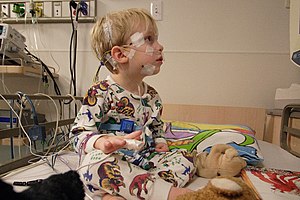Sleep disorder
| Sleep disorder | |
|---|---|
 |
|
| Pediatric polysomnography | |
| Classification and external resources | |
| Specialty | Sleep medicine |
| ICD-10 | F51, G47 |
| ICD-9-CM | 307.4, 327, 780.5 |
| DiseasesDB | 26877 |
| MedlinePlus | 000800 |
| eMedicine | med/609 |
| MeSH | D012893 |
A sleep disorder, or somnipathy, is a medical disorder of the sleep patterns of a person or animal. Some sleep disorders are serious enough to interfere with normal physical, mental, social and emotional functioning. Polysomnography and actigraphy are tests commonly ordered for some sleep disorders.
Disruptions in sleep can be caused by a variety of issues, from teeth grinding (bruxism) to night terrors. When a person suffers from difficulty falling asleep and/or staying asleep with no obvious cause, it is referred to as insomnia.
Sleep disorders are broadly classified into dyssomnias, parasomnias, circadian rhythm sleep disorders involving the timing of sleep, and other disorders including ones caused by medical or psychological conditions and sleeping sickness.
Some common sleep disorders include sleep apnea (stops in breathing during sleep), narcolepsy and hypersomnia (excessive sleepiness at inappropriate times), cataplexy (sudden and transient loss of muscle tone while awake), and sleeping sickness (disruption of sleep cycle due to infection). Other disorders include sleepwalking, night terrors and bed wetting. Management of sleep disturbances that are secondary to mental, medical, or substance abuse disorders should focus on the underlying conditions.
The most common sleep disorders include:
A systematic review found that traumatic childhood experiences (such as family conflict or sexual trauma) significantly increases the risk for a number of sleep disorders in adulthood, including sleep apnea, narcolepsy, and insomnia. It is currently unclear whether or not moderate alcohol consumption increases the risk of obstructive sleep apnea.
...
Wikipedia
